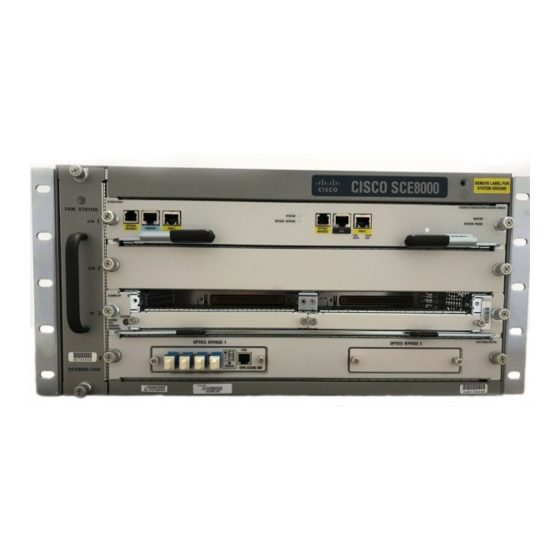Cisco SCE8000 GBE Manuel de démarrage rapide - Page 12
Parcourez en ligne ou téléchargez le pdf Manuel de démarrage rapide pour {nom_de_la_catégorie} Cisco SCE8000 GBE. Cisco SCE8000 GBE 25 pages. 10gbe platform
Également pour Cisco SCE8000 GBE : Manuel de configuration (18 pages), Procédures de retrait et de remplacement (36 pages), Installation (21 pages)

Figure 8
Connecting the Local Console to the SCE8000-SCM-E CON Port
S C E 8 0 0 0
Connect the other end of the serial cable (with an attached DB-9 or DB-25 connector) to the VT100 compatible local
Step 2
(serial) terminal.
Make sure the local terminal is configured as a VT-100 terminal, according to the fixed Cisco SCE8000 CON port
Step 3
parameters.
Make sure that the Cisco SCE8000 is powered on and has completed booting (this process may take several minutes).
Step 4
Step 5
Press Enter several times until the Cisco logo appears on the local terminal.
Setting Up Initial Parameters
For the SCE platform to communicate properly, set basic global parameters. The following is a summary of the initial setup
parameters and commands. For more information, refer to the Cisco SCE8000 Software Configuration Guide.
• IP address and subnet mask of the Cisco SCE8000 platform. This is the IP address used by the GBE management interface.
• IP address of the default gateway.
• Hostname—The hostname is used to identify the SCE platform. It appears as part of the CLI prompt and is also returned
as the value of the MIB-II object sysName.
The maximum length is 20 characters.
–
The default hostname is SCE8000.
–
• Passwords for user, admin, and root level access. These are authorization-level passwords, not individual passwords. These
passwords may be encrypted.
Passwords must meet the following criteria:
Minimum length—4 characters
–
Maximum length—100 characters
–
Begin with an alpha character
–
May contain only printable characters
–
• The default password for all levels is cisco.
• System clock—Current date and time. The clock and the calendar must always be synchronized.
• Time zone—The name or ID of the time zone along with the number of hours offset from UTC.
• Domain name server—Default domain name, which is used to complete unqualified host names, as well as up to three
domain name servers, which are used for DNS lookup.
You must also enable DNS lookup.
• RDR formatter destination—The SCE platform generates raw data records (RDRs) and sends them to the specified
destinations (external collection systems) through the RDR formatter. You can configure up to eight RDR formatter
destinations. For each destination, specify the IP address and port number.
12
1
2
3
- S C M - E
O P T IC A
L
B Y P A S
S 1
C O N S O
L E
P O R T 1
1 0 /1 0 0 /
1 0 0 0
L IN K /
A C T IV E
